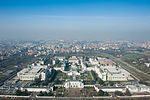Prato Centenaro
Districts of MilanFormer municipalities of LombardyProvince of Milan geography stubs
Prato Centenaro is a district (quartier) of Milan, Italy. It is an area located within Zone 9 of the city.
Excerpt from the Wikipedia article Prato Centenaro (License: CC BY-SA 3.0, Authors).Prato Centenaro
Largo San Dionigi in Pratocentenaro, Milan Municipio 9
Geographical coordinates (GPS) Address Nearby Places Show on map
Geographical coordinates (GPS)
| Latitude | Longitude |
|---|---|
| N 45.509166666667 ° | E 9.1991666666667 ° |
Address
Largo San Dionigi in Pratocentenaro
Largo San Dionigi in Pratocentenaro
20162 Milan, Municipio 9
Lombardy, Italy
Open on Google Maps








